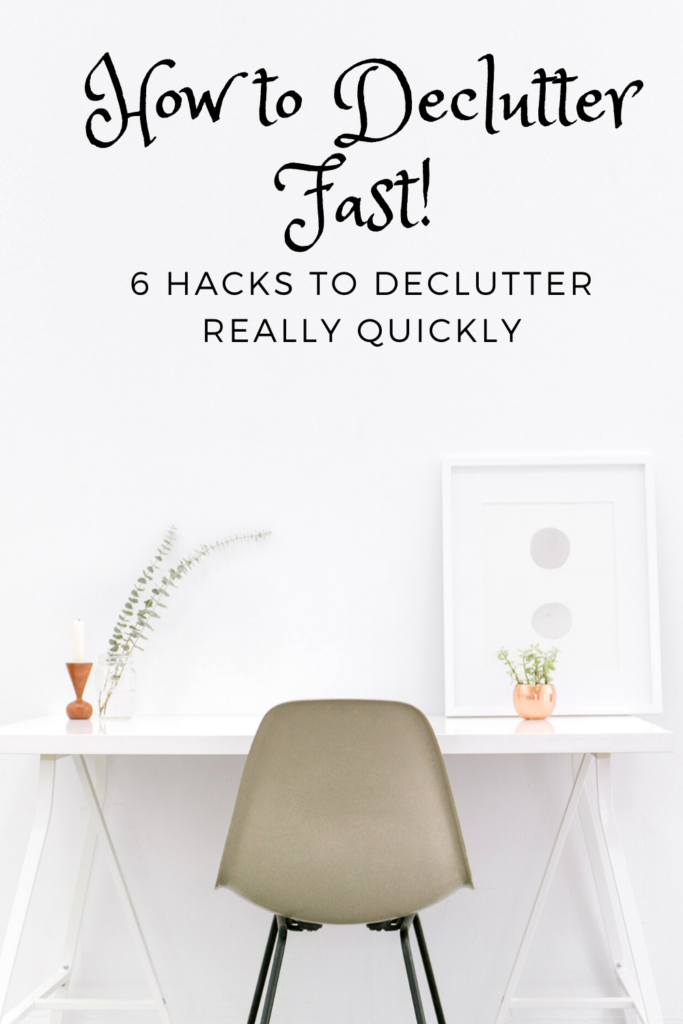So, you want a clutter free home? But you find deluttering overwhelming and time consuming.
Fear not! You can declutter super quickly and easily with my six super hacks. Without further ado:
Hack 1 – Pre-Made Clutter Decisions
The number one time-consuming area of decluttering is moments when you are staring at an item wondering what to do with it. You may have heard the phrase that clutter is just unmade decisions. This is definitely true!
Pre making collective decisions about what you to do with the clutter in advance makes the decluttering process much quicker.
Here are some of my premade decisions:
Anything that’s broken or not been used or worn in the last year, – gone.
Physical copies of books for adults – charity shop
Clothes that don’t fit or need mending – charity shop
Old batteries and charger – recycle
Spare batteries – plastic container in kitchen cupboard
Small electronics I no longer use- charity shop or recycle
Duplicate items that are surplus to requirements – charity shop
Before you start decluttering an area, scan it and see what kinds of items you will be making decisions on. Premake them before you start the decluttering process and it will run efficiently.
Hack 2 – Make sure there is an exit for the clutter
This is a simple tip I learned from reading The Organised Mom Method, by Gemma Bray. Gemma advises that before you declutter you should have an exit route for your clutter. Don’t just put it in a bin bag to deal with another day because then you aren’t getting rid of the clutter, you are just storing it somewhere else in your home. Know where the clutter is going to go when you have decided to get rid of it. Will it go to the charity shop, recycling, a friend who needs it, another room or the trash? Which brings me onto my next point.
Hack 3 – Get 4 Containers Ready In Advance
You will need 4 containers (either bags, boxes or another container) to sort your stuff whilst you are decluttering.
1.) A bag for rubbish
2.) A bag for recycling
3.) A bag for the charity shop
4.) A container (I normally use a laundry basket) for stuff that goes into another room.
Note: You can also have one more container for the “put on hold pile”. These are items that you cannot part with but are not sure you want to keep. This pile should be very small, so choose a small container! If there’s something you really can’t make a decision on, this is the pile it should go in. If you haven’t used, needed or wanted the item in the hold pile in 6 months – get rid!
Hack 4 – Set a Timer
Set a timer when you declutter. This is a really important step. It can be very time consuming to deliberate over whether or not you should keep an item. Having a set time helps you keep focused. It means that your decisions are based on instinct and helps you make decisions quickly. It doesn’t give time for your mind to convince you should keep items that are of no use.
The time set is up to you. I find 30 minutes is good. Enough to get in the flow, get things done and achieve a significant amount without getting overwhelmed. But 5 minutes and 10 minutes here and there can add up to a lot in the long run too.
Hack 5 – Clear Out First. Put Back Only What You Need
Clear one small area at a time. Start by emptying the drawer, shelf or container you are tackling first. Once you’ve cleared an area, take a moment to admire the new found space you have.
Only put back items you want to keep. It’s much quicker to clear a small area and then put back items you want rather than take out each item from an area and decide whether or not to keep it. It makes it easier to decide to throw things away this way round. As it’s much quicker and easier not to put it back.
Hack 6 – Work on Your Mindset
Develop a ruthless declutter mindset before you start. Remind yourself that each piece of clutter you have takes energy (money and time) out of your life whether that be to organise it, clean it, tidy it, mend it and / or store it. Items you keep must be worth the effort. Decluttering can make a huge difference to your life but you do have to be strong to be really minimalist (if that is what you want)
Remember most things you can buy again if you need them.
Some of the hardest items to get rid of can be sentimental. If deep down you want to part ways but are find it hard, taking a photo to keep digitally can help. This is especially useful when trying to part with a child’s artwork, trophy or certificate. Personally I keep one or two pieces of my kids schoolwork and take photos of anything else that is special to keep.
If you really can’t part with items that you think maybe you should be able to, keep them in a holding box (but reserve this for the few items that you struggle to part with). In a few months, you can review what’s in the holding box and it might be at this point you can let it go.

